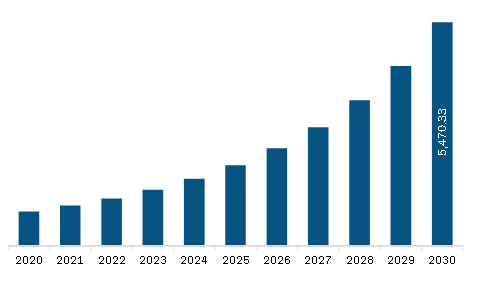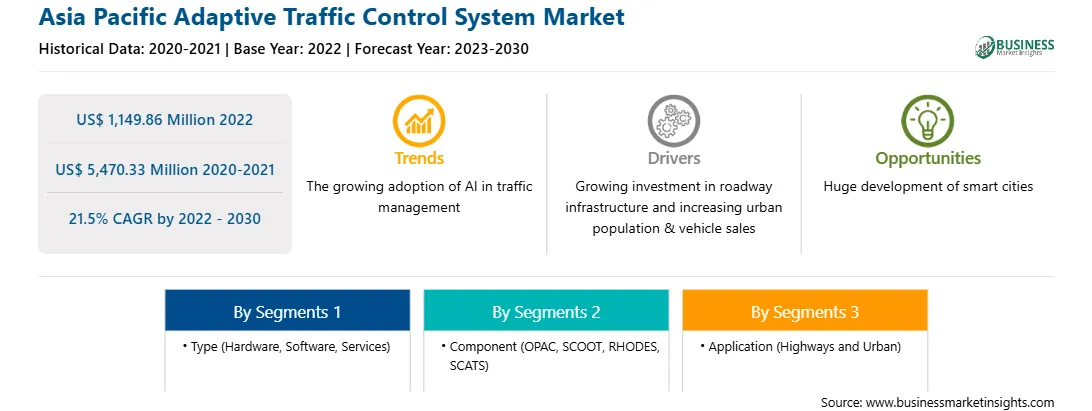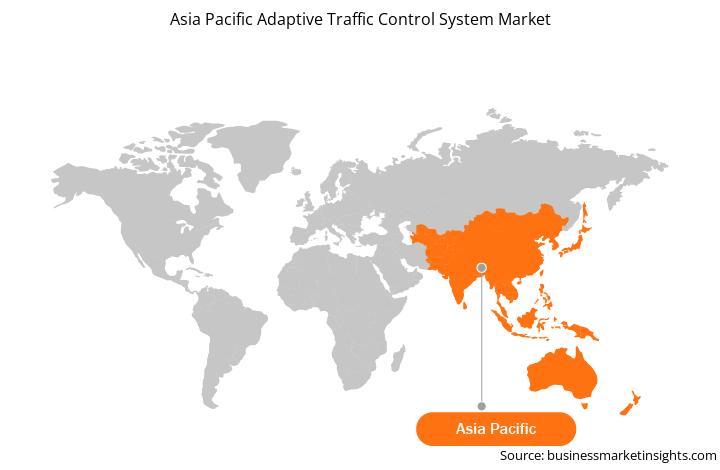Increasing demand for strong connectivity and developed infrastructure is raising investments in developing smart cities. Smart cities are technologically advanced urban areas which integrate a variety of sensors and electronic solutions which can help to gather data and utilize it for the betterment of the locality. In November 2021, the government of India announced its plan to invest ~US$ 700 billion in its smart city ramp-up plan during 2021–2031. Under this investment, the government will boost its urban infrastructure services, including urban mobility, affordable housing, and water security. Thus, the growing investments by governments in developing smart cities will provide long-term traffic management plans to optimize transportation logistics and reduce congestion, which is expected to raise the demand for adaptive traffic control systems globally.
It is also seen that along with smart cities, various countries are investing in developing smart roadways to provide a safe vehicle commute. Different types of sensors and hardware are deployed in smart roadways which helps to collect multivariate data that can be further used for traffic monitoring. This data can also be shared with vehicles traveling on the road, helping them to make informed decisions. In addition, vehicle manufacturers are also making IoT-enabled vehicles with sensors and devices that can help them gather various data. This vehicle data can be utilized to understand the congestion level at specific road sections, which can be further help to determine the average number of vehicles present at a specific point, and further estimate the traveling time for a vehicle. Based on such data, traffic on different lanes can be maintained, congestion can be predicted and avoided promptly, and the commuting time in urban areas can be lowered by 15–20%. Hence, the growing development of smart cities and increasing adoption smart roadways will provide lucrative opportunities for the growth of the Asia Pacific adaptive traffic control system market during the forecast period.
The Asia Pacific adaptive traffic control system market is segmented into China, India, Japan, Australia, South Korea, and the Rest of Asia Pacific. China and India are continuously witnessing population growth, which is creating the need for the construction of roads and highways to efficiently reduce traffic congestion. For instance, in June 2022, the government of China announced its plan to launch 120 new expressways and ordinary national and provincial highway projects, which will cover more than 3,600 km. A total investment of US$ 27.20 billion (182 billion yuan) by the government will be made on these projects. Moreover, rapid urbanization is increasing traffic congestion in the region, specifically in developing countries. According to the United Nations Organization, in 2020, New Delhi and Shanghai had 29 million and 26 million inhabitants, respectively. In addition, the cities such as Mumbai, Beijing, and Dhaka all recorded ~20 million inhabitants in 2020. This growing urban population is raising the need for the installation of superior traffic management solutions to further minimize pollution, which is expected to drive the growth of the Asia Pacific adaptive traffic control system market in the region during the forecast period.
Strategic insights for the Asia Pacific Adaptive Traffic Control System provides data-driven analysis of the industry landscape, including current trends, key players, and regional nuances. These insights offer actionable recommendations, enabling readers to differentiate themselves from competitors by identifying untapped segments or developing unique value propositions. Leveraging data analytics, these insights help industry players anticipate the market shifts, whether investors, manufacturers, or other stakeholders. A future-oriented perspective is essential, helping stakeholders anticipate market shifts and position themselves for long-term success in this dynamic region. Ultimately, effective strategic insights empower readers to make informed decisions that drive profitability and achieve their business objectives within the market. The geographic scope of the Asia Pacific Adaptive Traffic Control System refers to the specific areas in which a business operates and competes. Understanding local distinctions, such as diverse consumer preferences (e.g., demand for specific plug types or battery backup durations), varying economic conditions, and regulatory environments, is crucial for tailoring strategies to specific markets. Businesses can expand their reach by identifying underserved areas or adapting their offerings to meet local demands. A clear market focus allows for more effective resource allocation, targeted marketing campaigns, and better positioning against local competitors, ultimately driving growth in those targeted areas.
Asia Pacific Adaptive Traffic Control System Strategic Insights

Asia Pacific Adaptive Traffic Control System Report Scope
Report Attribute
Details
Market size in 2022
US$ 1,149.86 Million
Market Size by 2030
US$ 5,470.33 Million
Global CAGR (2022 - 2030)
21.5%
Historical Data
2020-2021
Forecast period
2023-2030
Segments Covered
By Type
By Component
By Application
Regions and Countries Covered
Asia-Pacific
Market leaders and key company profiles
Asia Pacific Adaptive Traffic Control System Regional Insights

Asia Pacific Adaptive Traffic Control System Market Segmentation
The Asia Pacific adaptive traffic control system market is segmented into type, component, application, and country.
Based on type, the Asia Pacific adaptive traffic control system market is segmented into hardware, software, and services. The software segment accounted the largest share of the Asia Pacific adaptive traffic control system market in 2022.
Based on component, the Asia Pacific adaptive traffic control system market is divided into OPAC, SCOOT, RHODES, and SCATS. The SCATS segment held the largest share of the Asia Pacific adaptive traffic control system market in 2022.
Based on application, the Asia Pacific adaptive traffic control system market is bifurcated into highways and urban (cities). The urban (cities) segment accounted a larger share of the Asia Pacific adaptive traffic control system market in 2022.
Based on country, the Asia Pacific adaptive traffic control system market is segmented into Australia, China, India, Japan, South Korea, and the Rest of Asia Pacific. China dominated the the Asia Pacific adaptive traffic control system market in 2022.
Aldridge Traffic Controllers Pty Ltd, Efftronics Systems Pvt Ltd, Trafiksol ITS Technologies Pvt Ltd, Kapsch TrafficCom AG, EFKON India Pvt. Ltd., Johnson Controls International Plc, and Q-Free ASA are some of the leading companies operating in the Asia Pacific adaptive traffic control system market.
The Asia Pacific Adaptive Traffic Control System Market is valued at US$ 1,149.86 Million in 2022, it is projected to reach US$ 5,470.33 Million by 2030.
As per our report Asia Pacific Adaptive Traffic Control System Market, the market size is valued at US$ 1,149.86 Million in 2022, projecting it to reach US$ 5,470.33 Million by 2030. This translates to a CAGR of approximately 21.5% during the forecast period.
The Asia Pacific Adaptive Traffic Control System Market report typically cover these key segments-
The historic period, base year, and forecast period can vary slightly depending on the specific market research report. However, for the Asia Pacific Adaptive Traffic Control System Market report:
The Asia Pacific Adaptive Traffic Control System Market is populated by several key players, each contributing to its growth and innovation. Some of the major players include:
The Asia Pacific Adaptive Traffic Control System Market report is valuable for diverse stakeholders, including:
Essentially, anyone involved in or considering involvement in the Asia Pacific Adaptive Traffic Control System Market value chain can benefit from the information contained in a comprehensive market report.